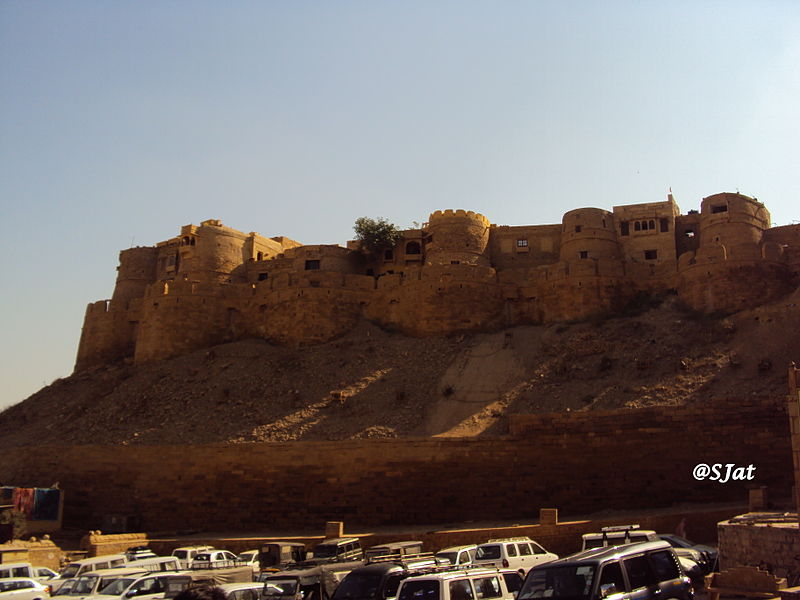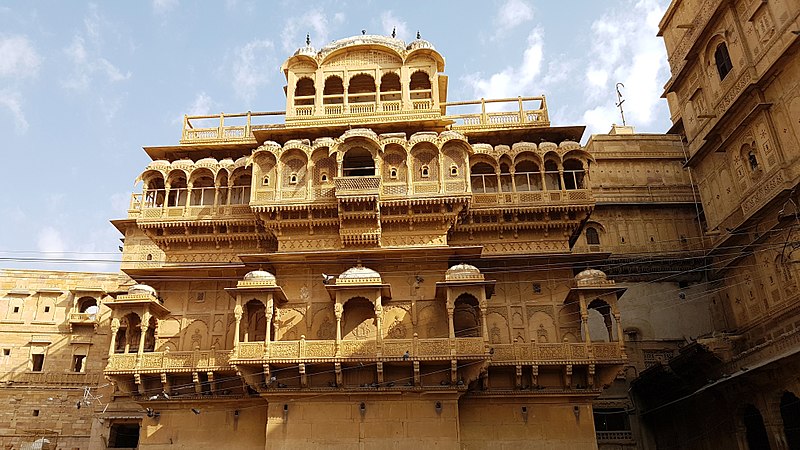Jaisalmer Fort, also known as Sonar Quila or the Golden Fort, is a formidable structure rising majestically from the golden sands of the Thar Desert in the city of Jaisalmer, Rajasthan, India. Renowned for its distinctive architecture, historical significance, and vibrant cultural life within its walls, Jaisalmer Fort stands as a living testament to the valor and grandeur of the Rajput rulers.

Built in 1156 AD by Rawal Jaisal, a Bhati Rajput ruler, the fort served as a strategic bastion along the ancient trade route that connected India with Central Asia and beyond. Its strategic location allowed it to control and prosper from the trade caravans that passed through the region.

The fort’s name, Sonar Quila, aptly reflects its appearance. Constructed with yellow sandstone, the fort glows like gold in the sunlight, creating a breathtaking sight that has earned it the moniker of the Golden Fort. The fort’s massive walls, rising up to 250 feet, stretch over 3,000 feet, making it one of the largest fully preserved fortified cities in the world.

One of the distinctive features of Jaisalmer Fort is its intricate architecture, characterized by its massive bastions, intricately carved balconies, and imposing gates. The fort is surrounded by a 30-foot-tall wall with 99 bastions, providing a formidable defense against invasions. The four gateways – Akshaya Pol, Ganesh Pol, Suraj Pol, and Hawa Pol – are masterpieces adorned with intricate carvings and serve as portals to the bustling life within.
Within the walls of Jaisalmer Fort lies a labyrinth of narrow winding lanes, havelis (traditional mansions), Jain temples, shops, and eateries. The fort is not just a historical monument but a living, breathing community where generations have lived and continue to live. The narrow lanes lead to hidden courtyards, where families reside, and vibrant bazaars, where local artisans sell their wares.
The architecture of the havelis within the fort is a reflection of the opulence and artistic finesse of the bygone era. The Patwon Ki Haveli, a cluster of five havelis, is renowned for its elaborate architecture, intricate carvings, and exquisite craftsmanship. Salim Singh Ki Haveli, with its distinct peacock-shaped balconies, is another architectural gem that captures the essence of Rajput architecture.
Jaisalmer Fort is also home to several Jain temples, known for their intricate architecture and exquisite carvings. The Jain temples within the fort include the Parshwanath Temple, Shantinath Temple, and Sambhavanath Temple, each dedicated to different Jain Tirthankaras.
The fort’s commanding location offers breathtaking views of the surrounding desert, and the vantage points within the fort provide stunning vistas of the city of Jaisalmer. The Maharawal’s Palace, located within the fort, offers a glimpse into the royal lifestyle with its richly decorated rooms, ornate balconies, and royal artifacts.
Jaisalmer Fort comes alive during the annual Desert Festival, a celebration of the vibrant culture, music, dance, and traditions of the region. The festival attracts tourists and locals alike, offering a unique opportunity to witness the rich cultural heritage of Jaisalmer within the walls of the fort.
Despite its historical significance and architectural marvels, Jaisalmer Fort faces challenges related to conservation and infrastructure. Efforts are underway to preserve and protect this UNESCO World Heritage Site, ensuring that future generations can continue to marvel at its beauty and appreciate its historical importance.
In conclusion, Jaisalmer Fort is not merely a historical structure but a living testament to the resilience and cultural richness of Rajasthan. Its golden ramparts, intricate architecture, and vibrant community within its walls make it a must-visit destination for those seeking to immerse themselves in the history, culture, and grandeur of the Rajputana legacy. As the desert winds whisper through its narrow lanes, Jaisalmer Fort stands as a silent witness to the sands of time, echoing tales of valor and the enduring spirit of a bygone era.

